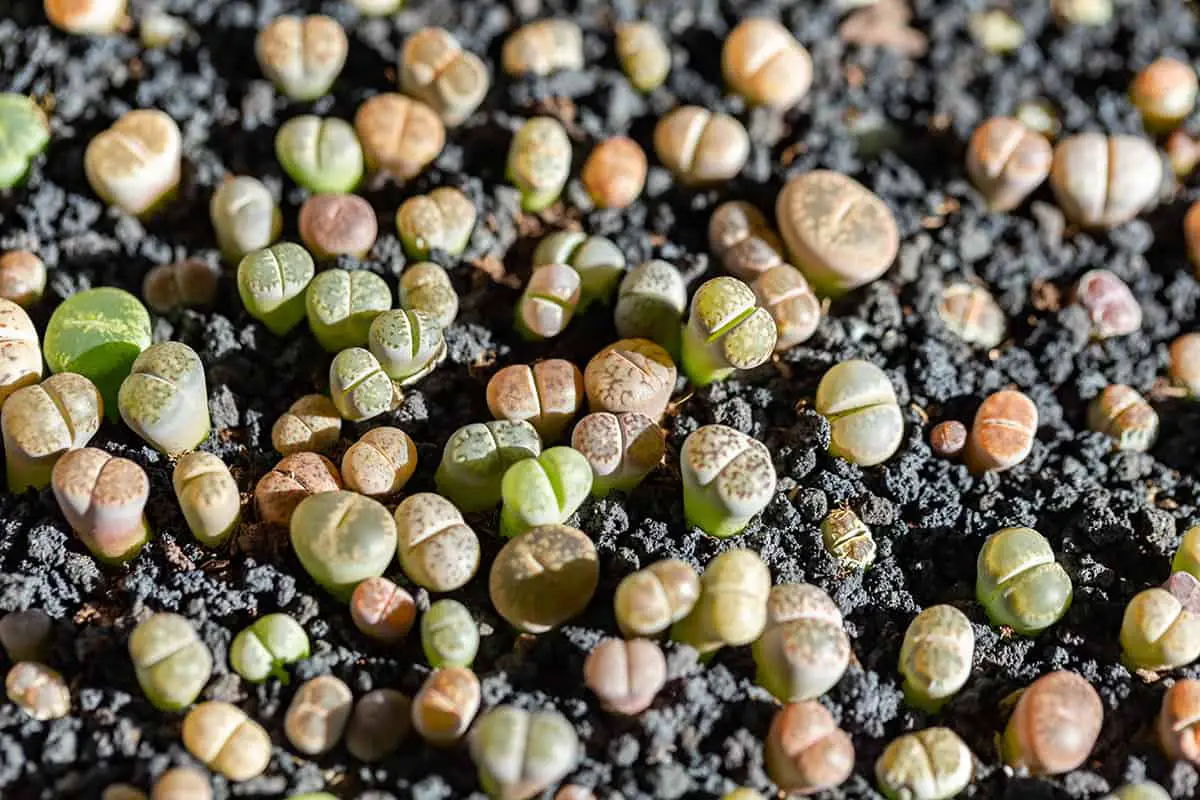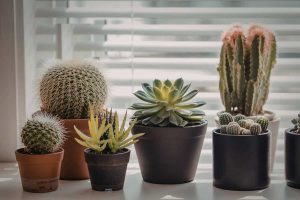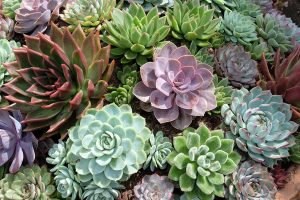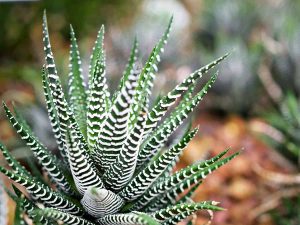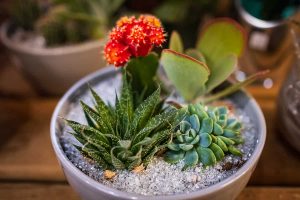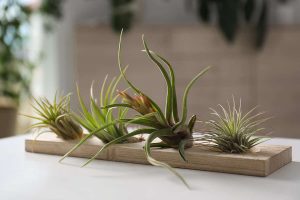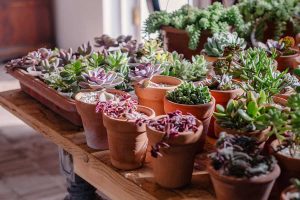Lithops, also known as Living Stones, are unique houseplants native to Africa. Known for their fleshy leaves and stone-like appearance, these plants can be a fascinating addition to your indoor garden. In this article, you’ll discover how to grow and care for Lithops.
Imagine discovering a plant that blends so perfectly with its surroundings that you might mistake it for a pebble. That’s exactly the charm of lithops, also known as “living stones.” These fascinating succulents, with their stone-like appearance, can thrive on your windowsill with the right care. This article will guide you into growing and caring for lithops.
| Common Name | Living Stones, Pebble Plants |
| Botanical Name | Lithops spp. |
| Family | Aizoaceae |
| History & Origin | Native to southern Africa |
| Plant Type | Succulent, Perennial |
| Mature Size | Up to 1 inch tall, 1-2 inches wide |
| Sun Exposure | Full sun to partial shade |
| Soil Type | Well-draining, sandy or gritty mix |
| Soil pH | Neutral to slightly acidic |
| Temperature | Prefer warm temperatures, avoid frost |
| Watering | Minimal; water sparingly in summer |
| Fertilizing | Light feeding during growing season |
| Bloom Time | Late summer to fall |
| Flower Color | Yellow, white, orange, or pink |
| Hardiness Zone | Varies by species, generally 9-11 |
| Toxicity | Non-toxic to pets and humans |
| Common Problems | Overwatering, rot, pests like mealybugs |
Table of Contents
Varieties of Lithops
Lithops Aucampiae
Lithops aucampiae are known for their beautiful patterns and colors. The top surface of this plant has a brownish-gray to reddish-brown color. They are perfect additions to your succulent garden if you seek uniqueness and charm.
Lithops Bromfieldii
The Lithops bromfieldii variety comes in various tinges of brown. They possess fascinating patterns, making it an attractive option for your collection. As a plus, the care for this variety is quite minimal, making it a low-maintenance choice.
Lithops Dorotheae
Lithops dorotheae is popular for its vibrant green color and striking red dots. Its appearance adds a unique touch, distinguishing it from other lithops varieties. Like its counterparts, this species requires little care, making for a beautiful yet easily maintained addition.
Lithops Fulviceps
With tinges of orange, yellow, and brown, the Lithops fulviceps exhibits an array of warm colors. Its striking appearance ensures it stands out in your succulent collection. Despite its bold look, this variety remains as low maintenance as the others.
Lithops Helmutii
If you prefer a subtler appearance, Lithops helmutii could be the variety for you. This species showcases a softer brown shade, embellished with beautiful patterns. They blend well with other succulents while adding a touch of elegance to your garden.
Lithops Hookeri
Lithops hookeri offers an appealing aqua and green theme, providing freshness and a calming ambiance. Like many other lithops varieties, they’re easy to care for and are perfect for both enthusiasts and beginners.
Lithops Julii
Lithops julii stands out with its distinctive white markings on green or grayish-green backgrounds. This combination creates a stunning visual effect, making it a captivating choice for any collection.
Lithops Karasmontana
If you’re a fan of red and orange hues, Lithops karasmontana will surely catch your attention. Their charming patterns and warm colors make them perfect additions to your succulent garden or indoor plant collection.
Lithops Lesliei
Encompassing shades of gray, green, and brown, the Lithops lesliei variety showcases its impressive variation patterns.
Lithops Localis
Lastly, Lithops localis stands out with its unique blend of green and gray tones. The fascinating patterns that embellish this variety are eye-catching and make for a stunning addition to your succulent garden.
Getting Started with Lithops

Choosing the Right Lithops
When selecting your Lithops plants, pay attention to their color, pattern, and size, as this can vary greatly among species. Native to southern Africa, these fascinating succulents are sometimes called living stones due to their appearance and stone-like patterns. Aim to choose healthy plants without any signs of damage or pests.
Required Supplies
To successfully grow and maintain Lithops, you will need the following items:
Well-draining potting mix: A combination of cactus soil with perlite, pumice, or coarse sand allows for proper drainage and prevents root rot.
Container with drainage holes: A pot or container that permits water to escape and reduces moisture helps maintain a healthy root system.
Watering tool: A device with a narrow spout enables controlled watering without drenching the potting mix.
Bright, indirect light: Providing a spot where your Lithops receive plenty of bright, indirect light ensures healthy growth while avoiding sunburn.
Planting and Caring For Lithops
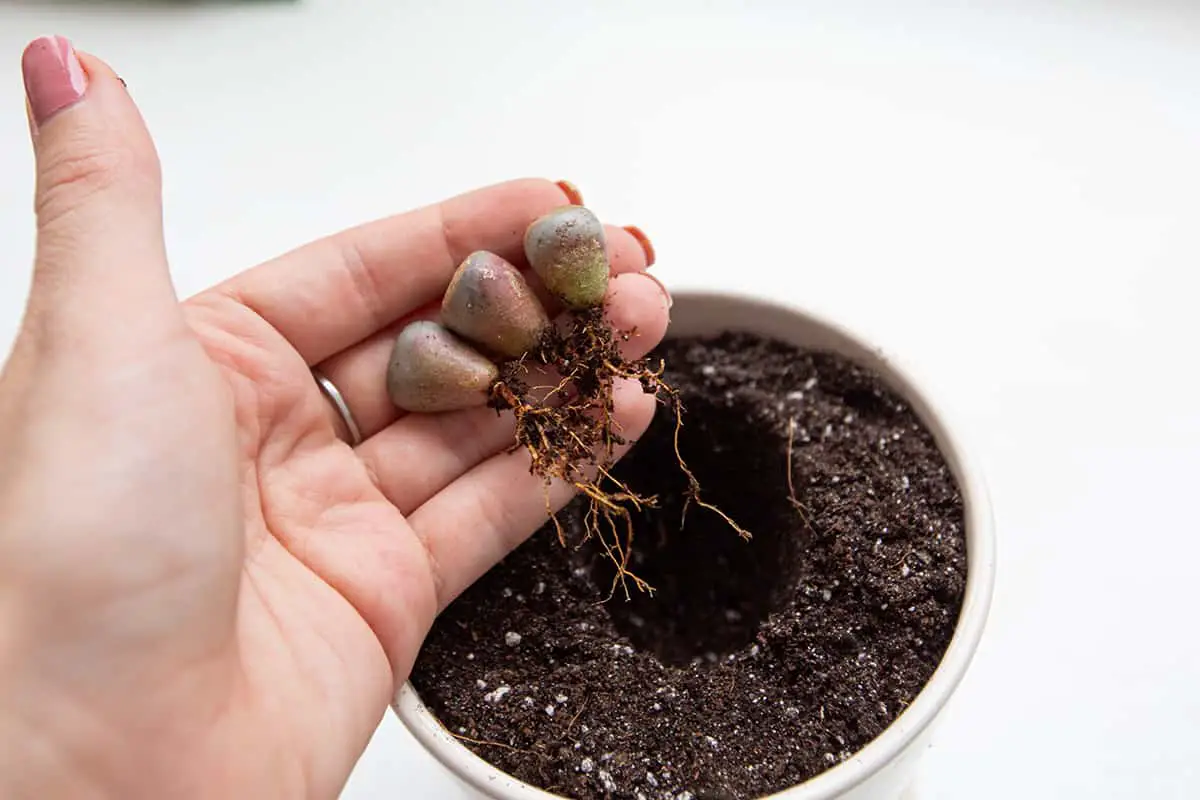
Soil
When planting Lithops, it’s crucial to use a well-draining soil mix to prevent root rot. You can create your own soil mix by combining equal parts of potting soil, perlite, and coarse sand. Adding pumice or crushed lava rocks can also enhance draining properties.
Planting
To plant Lithops, first choose a shallow, small container with drainage holes. Fill the container with the prepared soil mix, then take your Lithops and gently remove it from its existing pot. Be cautious while handling the plant to avoid damaging its leaves. Place the Lithops in the new container and fill any gaps with more soil mix.
After planting, water sparingly and provide adequate light for your Lithops to thrive.
Light and Temperature
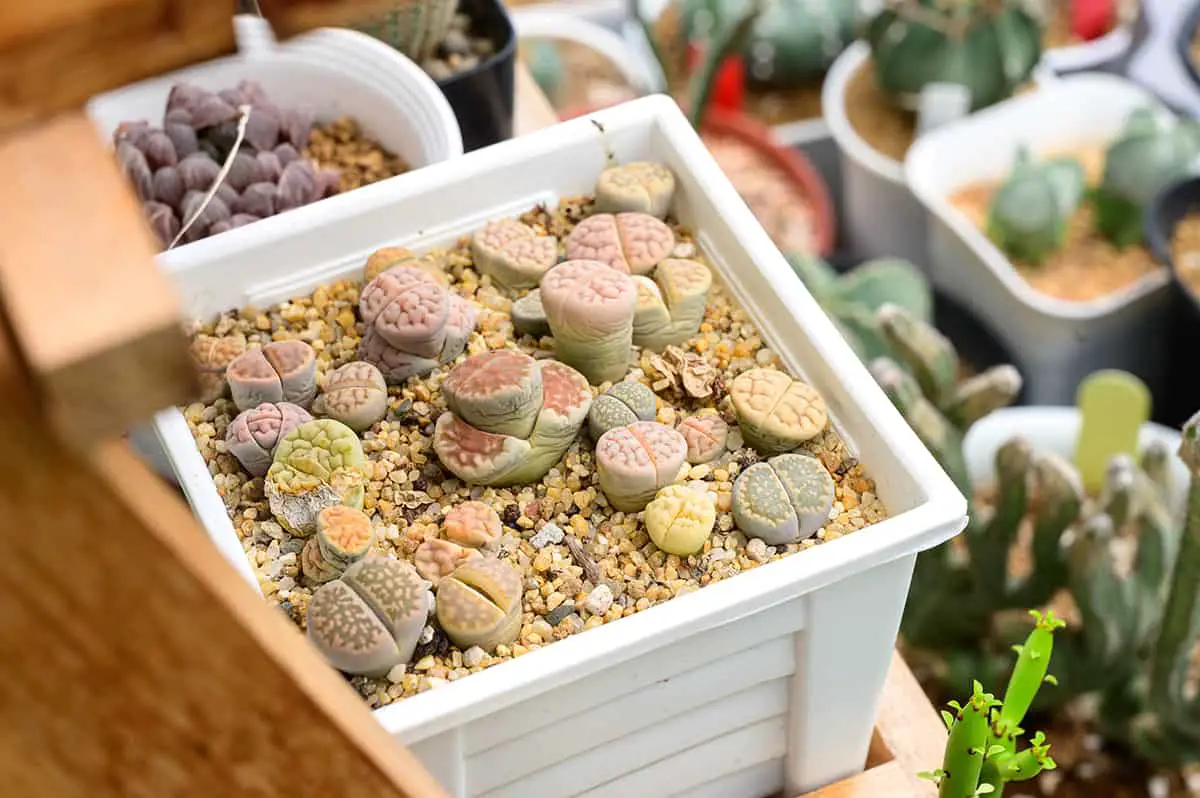
Lithops are native to Africa and require a sunny environment to grow properly. Ensure they receive at least 4-5 hours of direct sunlight each day, though they can tolerate partial shade. Keep in mind that excessive light may cause leaf discoloration.
As for temperature, Lithops can handle a range from 50-90°F (10-32°C), but keep them away from freezing conditions to prevent damage.
Watering
Lithops are succulent plants that require careful watering. To avoid overwatering, water them once every two weeks during their growth period. In winter, reduce the frequency to once a month. Always allow the soil to dry out completely between waterings.
Fertilizing
Lithops have modest fertilizing needs. Feed them with half-strength liquid cactus fertilizer once a year, preferably in early spring. Excessive fertilization can cause irregular growth patterns and may harm your plants.
Handling Dormancy Periods
Lithops require extra attention during their dormancy periods, which are divided into two distinct phases.
During the summer dormancy, which spans from late spring to early fall, reducing watering to just once a month is important.
Then, in the winter dormancy period, which lasts from late fall to early winter, you may observe your Lithops undergoing a “splitting” process. This fascinating natural phenomenon is your cue to cease watering altogether, waiting until the new growth has completely absorbed the old leaves before resuming any watering.
Propagation Methods
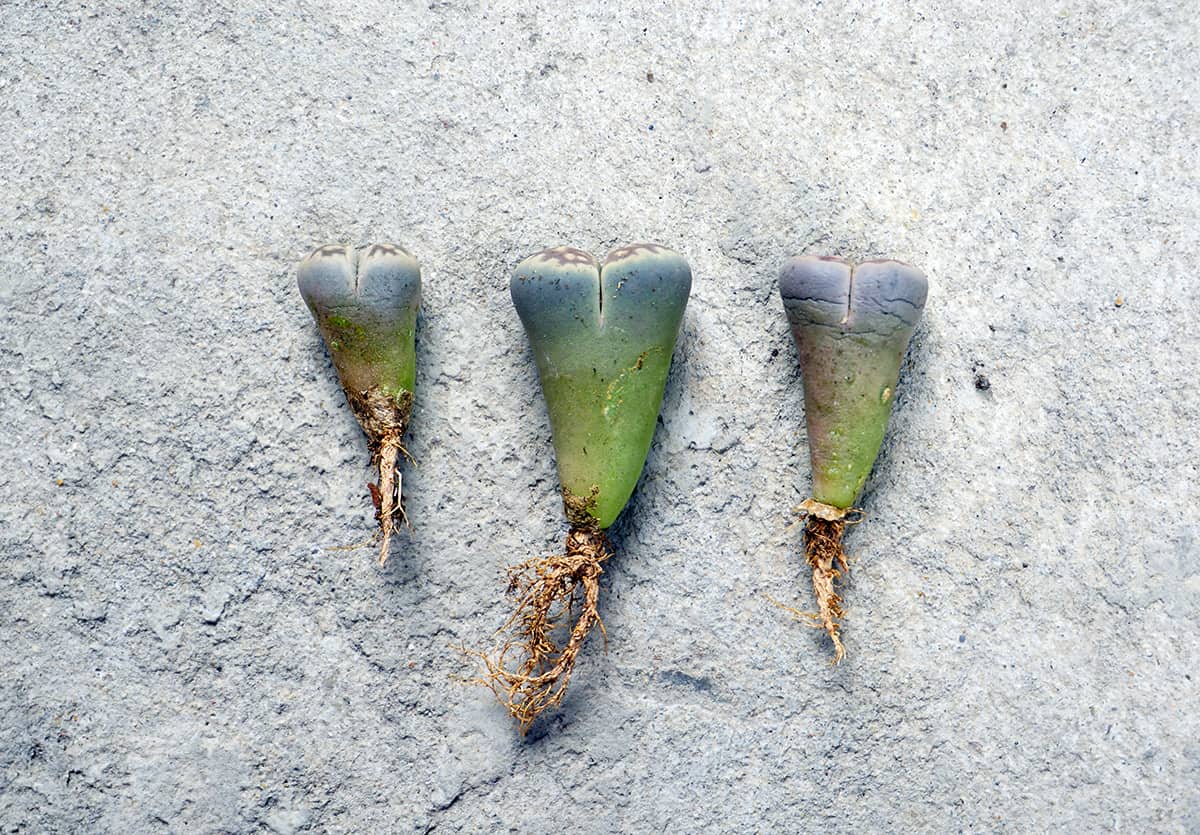
Seed Propagation
To propagate Lithops from seeds, begin by preparing a well-draining soil mixture. Fill small pots with the mixture and water it lightly, ensuring it is moist but not soaked.
Gently scatter the seeds over the soil surface. Do not bury the seeds, as they require light for germination. Place the pots in a bright, warm location, and maintain a slightly humid environment by covering the pots with a plastic wrap. Seedlings should emerge within two to three weeks.
Offset Division
Another way to multiply your Lithops collection is by offset division. When a Lithops plant produces new leaves, it sometimes generates offsets or small, separate growths. Carefully detach an offset from the mother plant using a clean, sharp knife. Allow the cut to dry for a couple of days, forming a protective callus.
Plant the offset in a well-draining soil mix, and maintain a steady watering schedule. The offset should root within a few weeks, establishing itself as a new, independent Lithops plant.
Troubleshooting Common Issues
Overwatering Symptoms
You should avoid overwatering your Lithops as it can lead to issues like yellowing leaves and a mushy appearance. Overwatered Lithops can suffer from root rot, dropped leaves, and eventually die. To prevent overwatering, let the soil dry completely between waterings and use a well-draining soil mixture. These are common problems and issues.
Pest Control
Pests such as mealybugs, aphids, or spider mites can affect your Lithops. It’s essential to identify the pests early and take necessary measures. To treat infestations, you can use a diluted mixture of dish soap and water. Clean the plant gently with a soft brush or cotton swab soaked in the mixture. You can also use effective natural insecticides to treat the issue without causing harm to your Lithops.
Disease Management
Diseases can primarily stem from overwatering or poor drainage, leading to the growth of fungi or bacteria. To prevent diseases, ensure proper watering practices, good drainage, and appropriate air circulation around your Lithops.
If you observe any signs of infection, remove the affected parts to prevent the spread and treat with appropriate fungicides or bacterial control solutions. Keep a close eye on your Lithops for any further issues, and maintain proper care to ensure their overall health.
Frequently Asked Questions
What is the ideal soil mix for growing Lithops?
To grow healthy Lithops, use a well-draining soil mix like a combination of 50% potting soil and 50% perlite or pumice. This mix keeps Lithops roots from sitting in water and helps prevent root rot.
When and how should Lithops be watered?
Water Lithops sparingly and infrequently to avoid overwatering. Spring and fall are the best times to water, when the plants are growing new leaves. Do not water during winter dormancy or the flowering period. Wait until the topsoil has completely dried before you water again.
How can you tell when Lithops are ready to flower?
Lithops typically flower during fall, from late September to November, although this can vary between species. You will notice a flower bud forming between the two leaves, followed by the slit opening, and finally, a daisy-like flower emerging.
Are there any specific species of Lithops that are easier for beginners?
Lithops karasmontana and Lithops aucampiae are two species that are considered easier for beginners because they tolerate a wider range of temperatures and adapt better to indoor conditions. Start with these species to develop your Lithops care skills before venturing into other varieties.
